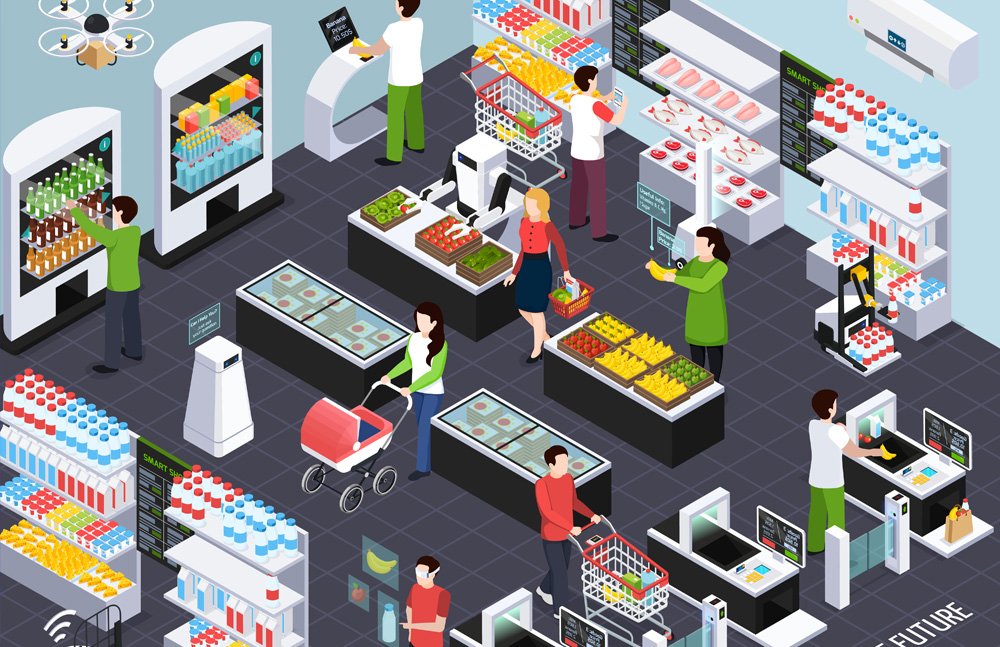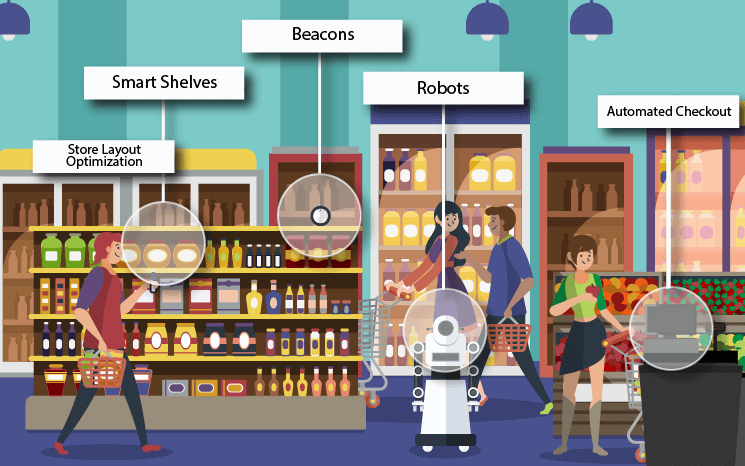The boons that accompany the Indian retail market are countless, but a handful of banes make it hard for retail businesses to attain the level of success they strive for.
With a nation as vast and diverse as India, rising customer expectations always one-up the existing retail infrastructure, and rightfully so. This challenges the market and coerces them into betterment for their sustenance.
One such difficulty that has been ailing India’s retail sector for some time now is maintaining customer loyalty and promoting retention. The ever-increasing competition amidst a growing retail market does not make achieving success more uncomplicated.
IoT in retail has been merging the online and offline spheres, driving customer engagement. All of this is courtesy of advanced data intelligence.
Being a part of the rat race, there’s little that retailers won’t do to get to the top, and looking for brand-new solutions to tackle existing issues always takes precedence. That is the only way to stay afloat. And IoT is coming up as a solution. So, let’s start by understanding…
What is IoT in Retail?
IoT stands for the Internet of Things. It is a system of interrelated computing devices, digital and mechanical machines, objects, and similar components- animate and inanimate- that come with unique IDs. They can transfer data seamlessly over a network without needing human-to-human and human-to-computer interaction.
The ‘thing’ in the Internet of Things (IoT) can include people with heart monitor implants, far animals with biochip transponders, or automobiles with built-in sensors to alert drivers whenever their vehicles’ tire pressure lowers.

The range of IoT in retail is vast, and it is only going uphill. Anything that can be assigned an Internet Protocol (IP) address and can transfer data over a seamless network falls under the banner of IoT.
Nowadays, more and more organizations in diverse industries are using the Internet of Things (IoT) to operate efficiently and better understand their customers. This shift aims to deliver enhanced customer service and improve decision-making, in turn adding to the value of the business.
Some Examples of IoT in Retail
With online shopping on the rise, retailers have been keen on welcoming frictionless customer experiences within the stores however they can.
The access to high-performance analytics and rich data helps understand retail customers better. The goal of IoT in retail is to have limitless control over customer experience.
Here are some of the latest innovations in the world of retail IoT:
Smart Trolley
Smart trolleys allow store-mapping possibilities. What it means is that your trolley map will guide you to your desired product with just a simple search. You will also get product suggestions based on your purchase history.
Your trolley will continue offering automated inventory updates of products that have been purchased and billed. You can avoid long checkout queues, and the retailer can gain more ROI on every customer transaction and sale. These trolleys also let you avail multi-payment options.
Smart Point of Sale (PoS)
With these, you can eliminate the hectic and time-consuming process of scanning individual barcodes at the point of sale. This leads to faster checkouts and improved customer satisfaction.
With your products getting billed and scanned promptly, as and when picked off the aisles and finalized, you save much valuable time, making the checkout process seamless and hassle-free.
EAS Solution
Electronic Article Surveillance systems have been touted for protecting your merchandise against potential shoplifters. With small security tags on high-theft merchandise, retailers are alerted whenever a shoplifter attempts to steal items through the electronic sensor-attached exit doors.
This leads to increased profitability and helps detect precise information about detected products. These systems track increasing sales every time things are lifted from locked aisles or behind counters and displayed on the live sales floor.
This helps create a pleasant shopping environment for customers.
Electronic Shelf Labels
Digital signage helps provide personalized and highly interactive shopping experiences. They help save costs on traditional print media labels while driving customer engagement.
They are equipped to display more information and enhance the overall omnichannel experience. This way, with ESL, you save plastic and paper and serve customers much more accurately.

Advantages of IoT in Retail Market
Businesses stand to gain a considerable lot with IoT solutions by their side. A good example, to begin with, is predictive equipment maintenance used to tackle equipment failure, energy, and other such issues concerning the horde of equipment employed in the retail sphere.
For example, a refrigerator unit with built-in sensors to predict maintenance issues affecting power consumption can help save up on electricity bills and monitor temperature instabilities.
With IoT in retail, moving merchandise becomes much easier, with the means to maintain and track transportation and optimize the path to suggest the best routes.
The use of GPS trackers to track and route vehicles has been skyrocketing lately, paving the way for improved accuracy driven by IoT.
Warehouse automation and robots are now demand-aware, letting us monitor sales opportunities- all in real time. What has always been aisles and shelves based on fixed schematics will gradually transform to include automated pallets that organize themselves based on real-time demand.
The connected customer demographic has been significantly impacting brick-and-mortar locations with the opportunity to check local inventory levels and in-store prices from their handheld devices.
The goal is to let IoT guide us to a point where businesses can provide customized best-price offers or offer location-based services from within the store in real time.
Targeting high-value, loyal customers for concierge services is one of the more personalized advantages provided by the IoT for the retail business. Sending mass promotions will soon become a thing of the past.
IoT in retail allows small stores to monitor mall traffic and analyze it across various retailers to better understand the shopping journey. Businesses can now bid farewell to expensive survey projects that aimed to understand if store staff was appropriately responsive to customer service demands.
Nowadays, with videos and WiFi foot-traffic monitoring made possible by the IoT, businesses can gauge whether customers tend to dwell over specific product areas. This lets us implement personalized digital marketing practices within the stores.
Conclusion: IoT in Retail Market
Lately, with the rise of IoT solutions across every industry, fulfilling customer demands is becoming easier. IoT devices have the power to connect stock rooms and in-store shelves, offering insights into product availability at varying locations. They are equipped to tackle diverse customer behaviour and accommodate a wide range of customer requirements.
The Internet of Things or IoT in retail is becoming a game changer both for businesses and customers as well.
And if you want to know how retail tech can help you with expansion, feel free to Contact Us mail us at hello@91sqft.com.


